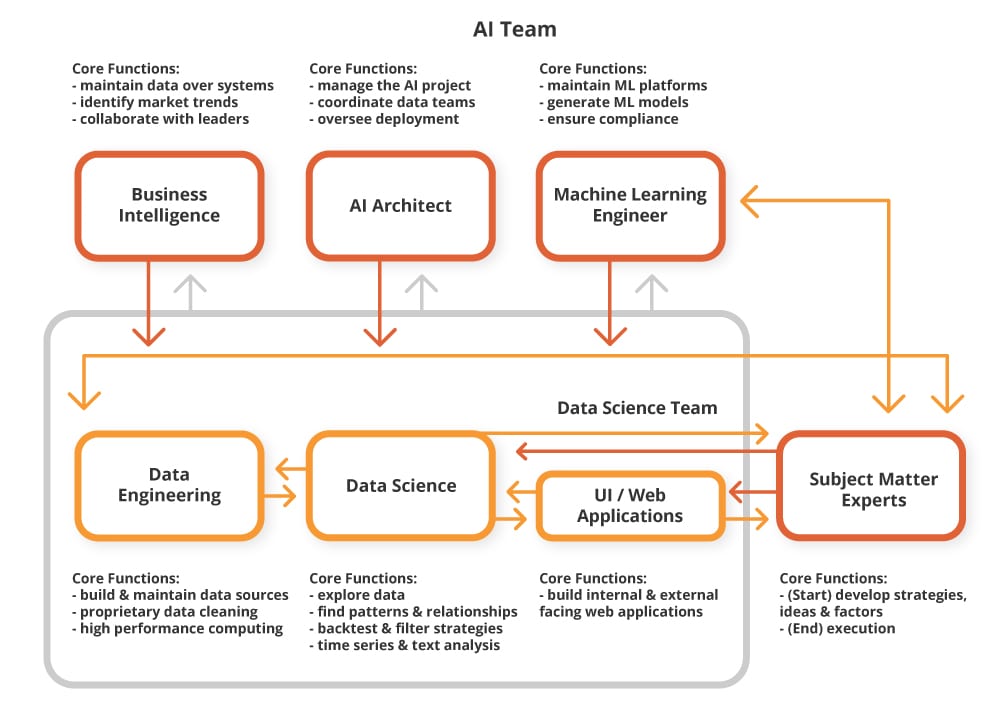navigation

Originally published February 25, 2021, updated May 16, 2022
The artificial intelligence (AI) market continues to grow 12.9% year over year, driven in part by more affordable neural networks, cloud computing infrastructure, and the increase in research tools and datasets.
Like any new and exciting technology, AI is receiving attention in the B2B eCommerce space. Some B2B brands address their challenges with transformative technology such as AI for eCommerce. But AI solutions for eCommerce don’t solve all business problems.
In this post, we cover the benefits and limitations of artificial intelligence eCommerce. We review requirements to implement AI, existing alternatives to AI, and the use of AI in eCommerce.
What is AI?
Artificial intelligence uses computers to process large amounts of data and analyze them in a non-linear format, just as the human brain would.

As shown above, the AI concept led to the development of machine learning. Deep learning followed machine learning. Now there are a wide array of subsets of AI, each specializing in a particular area.
Machine learning (ML) is an algorithm that teaches itself to make decisions based on past experiences. It analyzes data to reach conclusions, so more data means more accurate results. ML algorithms usually have an override function for the developer or end-user if predictions are inaccurate. An example of ML is an email spam filter that improves as it receives more spam.
Artificial neural networks (ANN) are interconnected algorithms that interact and process data as the human brain does.
Deep learning (DL) continuously analyzes data similar to humans. The main difference between ML is that DL relies on an ANN to make decisions. An ANN creates a system of probability-focused decisions with a feedback loop that allows the network to learn and improve its techniques over time. An example of DL is a voice-activated light switch learning that when the words can’t see and lights on are used together the switch should turn on.
Natural language processing (NLP) algorithms read, structure, and organize language in its natural-sounding form, relaying it to machines for further processing.
Natural language understanding (NLU) structures data and analyzes the intent behind language to understand what the user wants to accomplish.
Computer vision algorithms recognize, decipher, and compare image or video components and provide machines with data for action. They can draw conclusions from visual sources, compare, repair, or reconstruct media files.
Cognitive computing algorithms learn human and customer behavior and mimic human intelligence and decision-making processes.
How Does AI Work?

Whatever form it takes, artificial intelligence in eCommerce relies on large amounts of well-structured data. Machines identify and extract patterns in the data through trial and error, and as more data feeds the AI, it learns and generates better outcomes.
However, as smart as AI systems are, they still cannot operate without humans.
AI is just a means to an end, so the algorithms you select must be best suited for the task at hand. They must be designed, customized, tested, and taught to perform desired functions.
Machines make decisions based on the information humans provide, and this requires extensive data management. A common misconception is that AI is a complex algorithm. In reality, one of the most crucial aspects of AI is data. Data that must be audited, organized, and prepared to work with AI.
Then, you determine which algorithm model will be the most appropriate for your needs. Ready-made platforms known as Machine Learning as a Service (MLaaS) facilitate data processing, model training, and analytics. But still, they are not plug-and-play solutions. To build your model and test its accuracy, you must hire AI professionals and data scientists.
Who Builds and Maintains AI?
AI depends on many intelligent humans if it is to perform correctly.

With an increase in digital activity, cloud adoption, and the pivot to remote work, organizations have more information than ever. Most data is inefficiently distributed and stored in different systems. That’s where a data science team comes in. Data science and AI teams work with product managers, software engineering teams, designers, and other experts to build and maintain AI systems.
Data engineers plan and develop big data environments and prepare data for data scientists. They create ecosystems and communication channels between business systems to collect data. Companies usually look for candidates with experience in data management, migration, and visualization, including C++, Java to Python, R, and Scala.
Data scientists collect and analyze large datasets using ML and predictive analytics. They also develop algorithms that prepare data for cleaning and analysis. Data scientists require knowledge of Hive, Hadoop, Spark, Python, and other languages. They need analytical and communication skills to relay findings to team members.
UI/Web applications developers take over software development from the data science team. They are the software developers, integrators, and other IT professionals that build web applications. They must have a firm grasp of Java, JavaScript, CSS, HTML, and other frontend languages.
Subject matter experts can be technology and product managers that provide valuable insights from a specific domain to the data science team. Their role is to provide feedback, input, and guidance to ensure algorithms perform their business function correctly.
ML engineers build and manage ML models and maintain platforms that run ML projects. They work with data scientists and AI architects to ensure compliance with predetermined SLAs and requirements. Knowledge of C++, Java, Python, R, and Scala is required.
AI architects manage the overall AI project. They oversee the AI project deployment and maintain relationships between data scientists, data engineers, developers, business leaders, and other consultants. They must have strong computer science skills and proficiency in C++, Java to Python, R, and Scala.
Business intelligence engineers design, manage and maintain data infrastructure, and analyze complex sets of data. They supervise data across systems and communicate with the data team to mine, model, and prepare data. They should have SQL and SQL query and data warehouse knowledge.
Once a use case is complete, data scientists work with technology teams to generate appropriate methodologies to code the model. To clean, test, and scale the code, the data science team turns their models to AI teams and then to AI software engineers, who then perform the necessary work to make it production-ready.
Advantages of Using Artificial Intelligence in B2B eCommerce Companies
Below are five ways AI technology can help grow your eCommerce business, including virtual assistants and voice commerce, personalization based on customer behavior, searchandising, eCommerce automation, and optimizing the sales process.
- Enhanced customer experience: Apple’s Siri, Amazon’s Alexa, and Google Assistant are all virtual assistants most of you have heard of. In the context of eCommerce, virtual and voice assistants help handle simple inquiries. A virtual shop assistant provides quick and easy access to information for online shoppers via voice search and assists with product research on the eCommerce website.
- Efficient sales process: AI tools help you create a more efficient sales process, for example, by gathering data about your customers and automating follow-up abandoned cart emails. Sales automation in B2B eCommerce helps boost conversion rates and attract more potential customers.
- AI-powered automation: AI algorithms are great at enabling seamless automation of repetitive tasks. With AI, you can automate things like product recommendations, loyalty discounts, and low-level support, thereby simplifying workflows in the front- and back-end.
- Smarter search: AI tools enable innovative search solutions, such as faceted search, recommended product descriptions, autocomplete, relevant products, recent searches, and more. Also known as seachandising, this approach offers a user-friendly, personalized, and profitable online experience.
- Greater personalization in digital marketing and advertising: Developments in AI and machine learning technologies have enabled merchants to customize content for buyers. By analyzing big data, you can deliver personalized products offers, and relevant and helpful recommendations that resonate with your customers. Check out our guide on B2B eCommerce personalization for more examples.
Challenges to Using AI in eCommerce
While AI in eCommerce can and does enable better business decisions, prominent data scientist Robert Magoulas warns against rushing to embrace the technology. In a Harvard AI in Enterprise podcast, he cautions:

Deploying AI in eCommerce remains a costly, potentially risky endeavor. Leaders and AI advocates fail to identify AI use cases, lack necessary data, don’t have the right team or face a combination of these issues.
Make sure you have a use case
In a recent O’Reilly report, 20% of respondents cited difficulty in finding appropriate eCommerce AI use cases as the primary reason for not adopting AI. Make sure you have a use case that can’t be solved with other technology.
Some of the most common AI use cases in B2B eCommerce include:
- Product recommendations
- Sentiment analysis
- Predictive analytics
- Content and image recognition software
Do not confuse AI and workflow automation. You can develop a product recommendation algorithm or create a personalized checkout experience without using AI in eCommerce. If you are just starting your digital eCommerce transformation it’s better to start improving activities and experiences with less complex technology, such as automated workflows.
Do you have the human resources?
AI-powered and cloud-based eCommerce software implementation projects require professionals that understand the technical considerations and focus on the business value that AI solutions provide. Good AI specialists are expensive and hard to find.
Magoulas recommends hiring data scientists in groups – a diverse team fosters collaboration and skill-exchange that leads to better algorithms. The widespread AI talent gap across all skill, expertise, and experience levels means eCommerce companies are competing in a small talent pool.
Is your data in order?
ML algorithms rely on large volumes of quality data to classify, train, and refine their results.
The amount of data you need depends on your AI application and algorithm complexity, some estimates state that you should have 10 times the amount of data as dimensions of examples to feed your algorithm. The more data you have, the more accurate results you can expect from AI.
A garbage in, garbage out situation is the Achilles heel of AI in the eCommerce industry. Without a top-down approach to maintaining data quality, data governance, and data literacy, companies are blind to how their data situation impacts their AI project.
Do you have a supportive culture?
AI is a growing technology trend, and everyone has a different understanding of what it is and what it can do.
Before embarking on artificial intelligence in eCommerce, lay out the goals and how you will approach them. Get stakeholders onboard about what your AI project will deliver early on. Avoid burning through cash by setting milestones and releasing more funds once you reach progress. These tips will enable you to gradually improve and grow your project’s value.
AI Versus Automated Workflows
For most B2B businesses, AI in eCommerce is not the answer. Most companies are not prepared to adopt AI and often the technology is overkill for the problem. A rule-based workflow automation engine performs the job well and costs much less.
What are automated workflows?
Both workflows and AI use technology to complete tasks. While AI will learn, adapt, and take different courses of action, workflows always operate the same. Automated workflows utilize a condition-action logic to digitize business processes. They can automate many B2B order processing functions like performing credit approvals and notifying factory floor staff to perform specific tasks in defined sequences.
Customers, technologies, and processes evolve, and a flexible workflow automation engine enables you to act on opportunities as circumstances change. You continually improve and build on your processes, promoting a culture of innovation.
How are automated workflows and AI different?
This chart compares AI to an automated workflow to highlight the differences in required resources.
| Component | Automated workflow | AI |
| Data | Only requires data related to workflow | Prepare high volume of structured data across systems |
| Development | Minor configuration | Develop algorithms and ML platforms |
| Team | 1-2 developers to set up | 10+ data scientists for every ML engineer and architect |
| Support | Minor maintenance | Continuously supervise algorithms and data for accuracy |
Now, let’s compare the capabilities and role of artificial intelligence in eCommerce to automated workflows:
| Functionality | Automated workflow | AI |
| Data analysis | Analyzes complex data across systems | Analyzes complex data across systems |
| Repetitive tasks | Automates tasks of varying complexity | Automates tasks of varying complexity |
| Reports | Generates performance and customer activity reports | Generates performance, customer activity reports and enables sales forecasting |
| Data logging | Captures, organizes, and records values | Captures, organizes, records, and predicts missing values |
| Notifications | Notifies based on pre-defined logic | Notifies based on initial logic and then self-educates as it goes |
| Product recommendations | Uses predefined rules for recommendations | Uses demographics and activity for recommendations and self-educates to improve with time |
| Sentiment analysis | Can be pre-set based on if-this-then-that logic | Can parse email text or recognize sentiment in speech |
| Predictive analytics | Builds forecasts based on existing data and pre-set formulas | Builds predictions based on multiple data points, self-educates |
| Guided selling | Can send preset reminders to perform defined follow-up activities | Identifies deals at risk of not being won or predicts which item will be purchased |
Here’s how automated workflows and AI meet different eCommerce requirements:
| Requirement | Automated workflow | AI |
| Upsell, cross-sell, and display related products to customers | Based on a rule that is unique to a specific company or customer. | Based on engagement, click-stream, and customer profile data. |
| Analyze customer data from multiple touchpoints (mobile shopping apps, email campaigns, and websites) | Shows preferred way of performing online customer interactions. | Predicts when and through which channel the next order will be placed. |
| Analyze data on how, when, and where customers purchase products | Relay inventory management data to warehouses closest to vendors and customers. | Can combine with historical data and seasonal fluctuations to identify the warehouse for future stock. |
Automated workflows with human processes
Until technology catches up, AI won’t know your business like you do. By combining digitized and manual processes, you can enjoy the best of both worlds. When a workflow condition is fulfilled, automation takes action – either with human intervention or autonomously.
For example, if you need to identify orders with the best warehouse for shipping products, an AI system is unnecessary. An automated workflow can route orders to the closest warehouse for fulfillment. And the automated workflow will cost less to establish.
Artificial intelligence in eCommerce will better suit brands that need to offer anticipatory shipping and accurately predict product stocking locations close to the customers likely to buy. These systems can also anticipate individual customer tastes, forecast demand, or even weather conditions.
AI Use Cases in eCommerce for B2B
AI isn’t mainstream in B2B digital commerce but it is used. Here are some ways B2B businesses use AI in eCommerce to streamline back-office tasks, provide a personalized experience, and accelerate growth.
Personalized product recommendations
Personalized product recommendations directly impact conversion, and some eCommerce brands invest resources into AI-powered recommendation engines. For example, at least 35% of Amazon sales come from their machine-learned statistical models to recommend products.
In 2019, Amazon launched Amazon Personalize so merchants could utilize demographic information (age, gender, location) and user activity (signups, page views, purchases) to generate a library of items to recommend to help buyers discover products and accelerate buying decisions. Over time, Amazon Personalize examines this customer data and uses algorithms to train and optimize the model for effectiveness with data and products.
Sentiment analysis
According to G2, over 92% of B2B buyers are likely to purchase after reading trusted product reviews. As review numbers grow, some brands develop sentiment analysis systems to aid buyers reading reviews. For example, these models assist potential customers in understanding whether others think a product is spacious, expensive, or loud.
The Home Depot AI team built a sentiment analysis model using NLP and NLU to understand customer complaints and satisfaction. Home Depot saw a boost in engagement and conversion after deploying this system, particularly when combined with personalization.
B2B buyers demand the same shopping experience as B2C customers. This is driving the increasing popularity of NLP chatbots in B2B eCommerce. Last year, 81% of B2B buyers left a page because it required them to fill out a form. B2B brands are responding by introducing live chat AI applications and chatbots on their websites.
Predictive analytics
Modern businesses are trying to do more with the resources they have. For some enterprises, AI-based predictive analytics help react to competitive pressure and maximize business performance during uncertainty.
Kone, a Finnish elevator and escalator manufacturer, leverages the IBM Watson IoT platform to connect timely data to technicians. The model can anticipate wear and tear and prioritize maintenance schedules and spare parts before a service outage. The result is maximum on-site efficiency and customer satisfaction.
Media content recognition
Manufacturers and distributors are no strangers to machine vision and image recognition technologies. These systems inspect items on fast-moving production lines or identify missing pallets from warehouse shelves. Computer vision and related technologies are also used in eCommerce to classify images according to tag or category or to detect objects within them. By letting AI do image tagging, you can reduce error rates when processing images and ensure customers find what they want.
AI-driven facial recognition systems like the MicroProgram CyberLink FaceMe AI are finding their way into access control devices. CyberLink is a deep learning facial identification engine deployed in cloud-based solutions or integrated via SDKs onto edge devices. Aside from managing and controlling access to restricted areas, warehouses can enforce mask-wearing and comply with social distancing rules.
Integrating AI With B2B eCommerce
eCommerce platforms do not generally include native AI engines. If included, they provide a very narrow focus to a specific use case. If AI is in your future, you won’t be relying on the AI eCommerce platform, you’ll be relying on the ability of the platform to integrate.
MLaaS options offered by Google, Amazon, Microsoft Azure, and IBM cover most AI functions required to preprocess data, train and evaluate models, and generate predictions. These solutions use REST APIs to connect with other business systems. If this is the route you take, select a B2B eCommerce system with a reliable and scalable backend API.
But that’s not all. You need the ability to customize. Open-source eCommerce platforms like OroCommerce provide flexibility and the ability to easily customize. They provide a solution better suited to your AI integration needs than proprietary options.
In addition, select a B2B eCommerce platform supported by an extensive partner community that understands the full potential of the solution. This deep knowledge is essential in extending the solution to match your AI needs.
AI Should Solve Problems – Not Create Them
Demand for personalized and relevant customer experiences is increasing, and so is the desire for internal teams to maintain efficiency, alignment, and focus. It’s only natural that B2B sellers are interested in artificial intelligence eCommerce tools.
But, AI presents a host of challenges, such as data availability, the immense cost of building an AI team, and educating the algorithm. It’s not for early stage digital transformation initiatives.
Even companies with an established digital track record find it challenging to identify its true value proposition.
Still considering implementing artificial intelligence in eCommerce? Carefully evaluate whether AI is right for your customers, eCommerce industry, and business. You may discover that alternatives such as workflow automation, meet your needs, can be implemented faster, and cost less.
Frequently Asked Questions: AI Implementation in eCommerce
What is the role of AI in eCommerce?
AI in retail eCommerce is changing and shaping the industry to meet both consumer demands and business goals. eCommerce businesses use artificial intelligence to:
- provide personalized recommendations
- assist with visual search and pricing optimization
- automate manual processes,
- optimize a sales team performance by leveraging big data
- extract actionable insights from customer data
What is the future of AI in eCommerce?
The future for AI in online shopping and B2B eCommerce business is bright. 84% of eCommerce businesses are already actively implementing AI solutions into their business or have it as a top priority. Effective leverage of AI will eventually make eCommerce websites far more efficient at moving products than physical store. The growing use of AI in eCommerce stores is a sign of its long-term impact as a crucial eCommerce technology in this decade.
How is artificial intelligence transforming the eCommerce experience for B2B customers?
eCommerce AI makes the B2B customer experience smoother, more personalized, and interconnected. It improves the shopping experience through:
- AI-powered search engines that use contextual AI
- more accurate, targeted recommendations engine
- digital shopping assistants, website, and feature apps centralized in one place.



